National Adoption Day this November 22 and National Adoption Month this November afford a time to share experiences and reflect on families. Whether you have students who have been adopted or are part of a family considering adopting a child into your home, all children can benefit from learning about adoption. Children are very curious about each other’s families, quick to categorize into groups, and intent to define what makes a family, well, a family. Continue reading
Category Archives: Educator Resources
Lesson plans, activity guides, and helpful tips from our literacy specialist and guest educators.
5 Harmful Differentiation Myths: Part 1
The learning differences, preferences, and varied backgrounds existent in the classroom present teachers with a challenging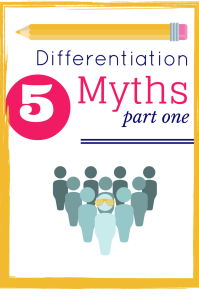 task: help every student become a successful learner. How can teachers support all students’ diverse needs? Much confusion and fear have surrounded differentiated instruction and its use in the classroom.
task: help every student become a successful learner. How can teachers support all students’ diverse needs? Much confusion and fear have surrounded differentiated instruction and its use in the classroom.
Myth #1: Differentiation = Individualization
Differentiation doesn’t mean individualizing the curriculum for each student. Yes, when teachers meet one-on-one and conference with students, modifying instruction to best suit the student’s needs, both individualization and differentiation are taking place. However, writing an individual lesson plan for every student in the classroom is NOT differentiating (it’s insanity). Instead, differentiation involves using quality and effective instructional practices to strategically address groups of students based on various levels of learning readiness, interests, and learning styles.
 Myth #2: Every student should be doing something different
Myth #2: Every student should be doing something different
First Look, Second Look, Third Look: Close “Reading” with Book Art
I’ll admit it: I was looking for a Native American book by a Native American author to write about in light of Thanksgiving and National American Indian Heritage Month as many teachers do this time of year. Continue reading
Reading Paired Texts to Increase Student Engagement
In the fall of 2012 a news story emerged that astronomers had discovered a planet largely made out of diamond. Third grade at my school spent the first two quarters studying the solar system; therefore, this news was received with irrepressible glee in my classroom. Although the media nickname “Lucy” was lost on my students (as in the Beatles’ “Lucy in the Sky with Diamonds”), the wonderment and rejuvenated commitment to the content were obvious.
Seeing that scientists were still studying and discovering facts about our solar system and distant others was exciting to my students and made them feel like they were on the frontier learning alongside real astronomers. Pairing the news article with The Magic School Bus: Lost in the Solar System spurred very creative journal entries throughout the unit, including envisioned future discoveries of all sorts of substances for planets: kitten fur, gold, bubbles.
Incorporating current events and news stories into the classroom can engage students with a renewed sense of purpose and interest. Pairing a news article with a book on a similar topic or theme offers students greater context and a sense of relevancy for the content they are learning, and perhaps a jolt to the creeping apathy over a curriculum students had little input in selecting.
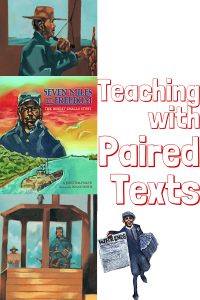 So, what does it look like to use paired texts in the classroom?
So, what does it look like to use paired texts in the classroom?
How to Teach Close Reading Using a Recipe
What happens if we don’t follow a recipe? Potentially, a disaster. Recipes require careful reading and we can literally taste the consequences of our failure to do so. In this way, a recipe is fantastic for small group instruction, such as guided reading, and for parent-child practice because it is grounded in real world applications and requires multiple re-readings to grasp the information.
For guided reading, there were only a dozen or so book sets that I used with my students because those available to me were dated in content (think: Pluto is still a planet) and image, worn out from being shared across the whole school, and unreliable in student engagement. On one of my monthly trips to a Friends of the Library book sale, where I often scrounged, hunted, and bargained, I discovered a milk crate full of the children’s literary magazine, Cricket. As these were used periodicals, they were available for free. I remember the award-winning magazine as a child myself and quickly discovered that the wide variety of high-quality texts would be perfect for guided reading, including the recipes and craft instructions.
 Young readers can use recipes to analyze an author’s choices, such as the order of steps, choice of ingredients, and ingredient amounts. Recipes provide hands-on experience at home while building critical background schema and additional practice with a nonfiction text. Recipes are great for teaching close reading because they:
Young readers can use recipes to analyze an author’s choices, such as the order of steps, choice of ingredients, and ingredient amounts. Recipes provide hands-on experience at home while building critical background schema and additional practice with a nonfiction text. Recipes are great for teaching close reading because they:
- naturally engage students with the content (yum!)
- create real-world connections for why we learn to read and the skill of close reading (look—even adults do it!)
A Visit With the Open Book Foundation
![]() Illustrator Frané Lessac shares a recent school visit that she and her husband, author Mark Greenwood, did in Washington, D.C. with An Open Book Children’s Literacy Foundation.
Illustrator Frané Lessac shares a recent school visit that she and her husband, author Mark Greenwood, did in Washington, D.C. with An Open Book Children’s Literacy Foundation.
One of the highlights of our recent US tour was our visit to Washington, D.C. and our Open Book Foundation day, working with three second grade classes at Savoy Elementary.
The foundation’s mission is to promote literacy among disadvantaged children and teens in the greater Washington, D.C. area by giving books to students and providing access to authors and illustrators – and what a unanimously positive experience it is for all involved!

Inspiring the Next Architects: Children’s Books About Design, Building, and Architecture
Celebrate architecture and design for Archtober with students!
October, or “Archtober” as it is called, marks the 4th annual month-long festival of all things architecture and design in New York City.
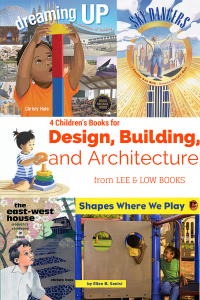 Recommended reading to teach about architecture for students:
Recommended reading to teach about architecture for students:
Teaching Cinderella Stories from Around the World
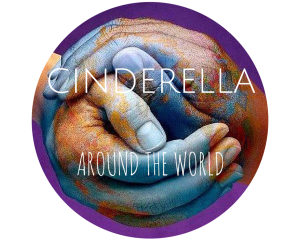 With the welcoming of ghoulish decoration displays and the buzz of Halloween costume ideas, the streets will soon be filled with candy-hungry witches, superheroes, and beloved fairy tale characters. Of all the many treasured fairy tale characters that come and go in popularity, none seems to be more resilient than Cinderella. But this Halloween, Cinderella doesn’t have to just mean the classic blue ballroom gown and glass slippers…
With the welcoming of ghoulish decoration displays and the buzz of Halloween costume ideas, the streets will soon be filled with candy-hungry witches, superheroes, and beloved fairy tale characters. Of all the many treasured fairy tale characters that come and go in popularity, none seems to be more resilient than Cinderella. But this Halloween, Cinderella doesn’t have to just mean the classic blue ballroom gown and glass slippers…
Whether you are planning your Cinderella unit this time of year or are brainstorming with young readers on Halloween costume ideas, Lee & Low Books is proud to present the Cinderella Around the World series. This collection of five diverse Cinderella stories from our Shen’s Books imprint features stories of Cinderella from several different cultural perspectives. Cinderella has been told for centuries across many distant lands and cultures from around the world. Readers will discover a range of settings, cultures, traditions, and characters as they explore Cinderella tales from Southeast Asia, India, and Mexico.
How Common Core’s book choices fail children of color
The Common Core has become a hot-button political issue, but one aspect that’s gone lar![]() gely under the radar is the impact the curriculum will have on students of color, who now make up close to 50% of the student population in the U.S. In this essay, Jane M. Gangi, an associate professor in the Division of Education at Mount Saint Mary College and Nancy Benfer, who teaches literacy and literature at Mount Saint Mary College and is also a fourth-grade teacher, discuss the Common Core’s book choices, why they fall short when it comes to children of color, and how to do better. Originally posted at The Washington Post, this article was reposted with the permission of Jane M. Gangi.
gely under the radar is the impact the curriculum will have on students of color, who now make up close to 50% of the student population in the U.S. In this essay, Jane M. Gangi, an associate professor in the Division of Education at Mount Saint Mary College and Nancy Benfer, who teaches literacy and literature at Mount Saint Mary College and is also a fourth-grade teacher, discuss the Common Core’s book choices, why they fall short when it comes to children of color, and how to do better. Originally posted at The Washington Post, this article was reposted with the permission of Jane M. Gangi.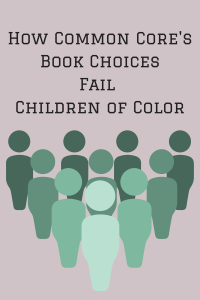
Children of color and the poor make up more than half the children in the United States. According to the latest census, 16.4 million children (22 percent) live in poverty, and close to 50 percent of country’s children combined are of African American, Hispanic, American Indian, Asian American heritage. When the Common Core State Standards (CCSS) were introduced in 2009—2010 , the literacy needs of half the children in the United States were neglected. Of 171 texts recommended for elementary children in Appendix B of the CCSS, there are only 18 by authors of color, and few books reflect the lives of children of color and the poor.
When the CCSS were open for public comment in 2010, I (Gangi) made that criticism on the CCSS website. My concerns went unacknowledged. In 2012, I presented at a summit on the literacy needs of African American males, Building a Bridge to Literacy for African American Male Youth, held at the University of North Carolina in Chapel Hill. Emily Chiarello from Teaching Tolerance acknowledged the problem and connected me with Student Achievement Partnership, an organization founded by David Coleman and Sue Pimental, “architects” of the English Language Arts standards.
Gender Matters? Swedish Picture Books and Gender Ambiguity
![]() Back in June, Laura Reiko Simeon wrote about how race is handled in Swedish picture books. We’re thrilled to host Laura again as she sheds light on how Swedish picture books handle gender and gender-ambiguous characters.
Back in June, Laura Reiko Simeon wrote about how race is handled in Swedish picture books. We’re thrilled to host Laura again as she sheds light on how Swedish picture books handle gender and gender-ambiguous characters.
You sit down with your favorite 4-year-old to read a sweet, wordless picture book featuring a little duck swimming down the river. Quickly, without thinking too hard, what pronoun do you use to describe the duck? Do you say, “Look at him paddle past that shaggy dog!” or “What does she see in the sky?”
If you were like the mothers in a 1985 study, you would use masculine pronouns for 95% of animal characters with no gender-specific characteristics. A follow-up study from 1995 examined children’s use of pronouns and found that by age 7 they had absorbed and were repeating these same gender stereotypes. Listen to those around you: has it changed much since then?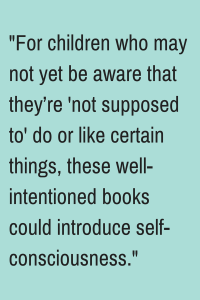
In the US, Sweden is widely regarded as a leader in gender equality, although many Swedes still see a need for greater progress. Meanwhile, our own biases are apparent, for example when we consider gendered toys. Compare this 1981 Lego ad, with its blue jeans and t-shirt-clad girl to the pink-infused products targeted at girls today. As with other social issues, picture books reflect concerns in society at large – but how they’ve done so is dramatically different in the US as compared to Sweden.



